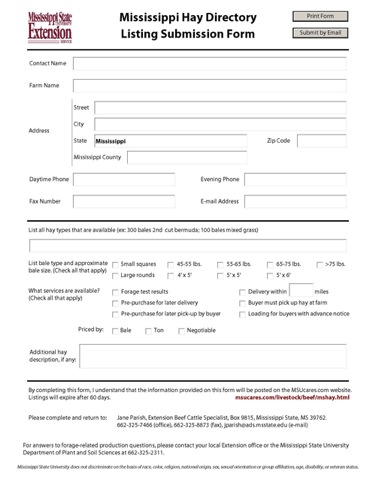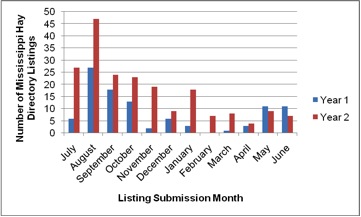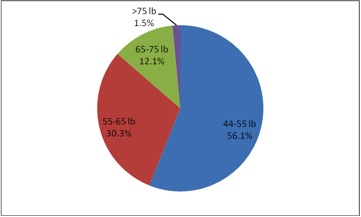 |
April 2009
|
April 2009 // Volume 47 // Number 2 // Tools of the Trade // v47-2tt4
Use of an Internet-Based Hay Directory in Beef Cattle Extension Programming
Abstract
Commodity directories are often considered services but can also be used to collect current information for use in Extension programming efforts. An Internet-based hay directory was established in response to beef cattle producer requests. Mississippi Hay Directory listing criteria and submission methods were chosen by Extension personnel to collect statewide hay production demographics and producer communication method use information. Analysis of directory listings over a 2-year period provided Extension personnel with valuable information for future producer education efforts. Directory evaluation results indicate that it was successful in achieving its objectives. Directory use by producers exceeded expectations and continues to expand.
Introduction
An Internet-based hay directory was initiated by the Mississippi State University Extension Service in July 2006. The directory began in response to beef cattle producer requests during a period of drought and hay scarcity in Mississippi. Extension beef cattle specialists developed specific listing criteria and collected directory information over a 2-year period to obtain demographics about Mississippi hay production for use in Extension programming. Multiple directory listing submission methods were offered to gauge producer use of these different communication methods. This information assisted Extension personnel in planning future producer communications. Data submitted through the Mississippi Hay Directory also facilitated the identification of educational needs of forage producers. Producer use of the directory increased throughout the study period.
Mississippi Hay Directory Development
Mississippi State University Extension Service personnel designed the Mississippi Hay Directory listing criteria to include key demographics regarding hay production in the state. A listing form appears in Figure 1. Information requested from hay producers included specific details in the following categories.
- Producer contact information
- Forage species
- Quantity of hay offered
- Bale type and size
- Services offered
- Pricing method
- Additional hay description
Figure 1.
Mississippi Hay Directory Listing Submission Form
Clientele utilizing the directory to advertise hay for sale were provided multiple listing submission options, including:
- Completion and submission of portable document format (pdf) form online
- Download and later e-mail submission of online form
- Fax of printed form
- Mailing of printed form
- Telephone contact for oral submission of data
County and area Extension educators were supplied with printed copies of the directory listing submission form and were encouraged by state specialists to assist producers with listing submission upon request. The listing submission form was direct mailed to members of the Mississippi Beef Cattle Improvement Association and distributed at county meetings of the Mississippi Cattlemen's Association during the initial six months of the directory. The Mississippi Cattlemen's Association magazine, Cattle Business in Mississippi, included hay directory advertisements in each issue. This publication was distributed 10 times per year to approximately 4,000 persons each issue. Directory guidelines, listing submission forms, and relevant producer education information were posted on the Mississippi State University Extension Service beef cattle Web site <http://msucares.com/livestock/beef/mshay.html> along with the directory.
Directory listings were received by state Extension beef cattle specialists. Listings were updated at least weekly and often within 48 hours of listing submission. Thorough review and editing of listing submission information was necessitated by spelling errors, irrelevant information, and listing claims that were deemed inappropriate for the directory.
Directory Use
Directory usage tended to increase over time. Listing submissions doubled in the second year. Listings by month and year appear in Figure 2. Listing submissions increased in the late spring months as hay production increased, steadily increased throughout the summer months coinciding with peak hay production, and then declined throughout the autumn and winter months as hay harvests slowed and supplies were used for winter feeding programs. Listings were received from 78% of Mississippi counties.
Figure 2.
Mississippi Hay Directory Listing Submissions by Month and Year
Web site usage statistics show that, in the first 15 months of existence, the directory listings were downloaded 12,184 times. In the second year, the directory Web site recorded 8,362 unique page visits. Increased use of the beef cattle Extension Web site also resulted.
Communication Method Use
Fax submission of hay directory listings was the most utilized method of communication in both the first and second years of the directory. Use of electronic methods of communication (Internet and e-mail submission) accounted for 39.0 percent of listing submissions in year 1 and 42.1 percent of listing submissions in year 2. This indicates that a significant proportion of hay producers are willing to use electronic communication methods. Direct mail and telephone submissions were the least utilized communication methods over the 2-year period (Table 1).
| Listing Communication Method | Percentage of Listings in Year 1 | Percentage of Listings in Year 2 | Percentage of Listings in Both Years |
| Fax submission | 25.0% | 43.1% | 37.1% |
| Internet submission | 14.0% | 30.2% | 24.8% |
| E-mail submission | 25.0% | 11.9% | 16.2% |
| Telephone submission | 21.0% | 6.9% | 11.6% |
| Direct mail submission | 15.0% | 7.9% | 10.3% |
Hay Production Demographics
Most hay listings (56.1 percent) offered hay in large round bale packages. Small square bales accounted for 25.7 percent of the listings. Other listings did not denote the bale package. No listings indicated that hay was baled in large square units or as baleage. Of the large round hay bales, the majority (58.8 percent) were four feet wide and five feet in diameter (Figure 3). Figure 4 illustrates that, of the small square hay bales, the majority (56.1 percent) weighed 45 to 55 pounds.
Figure 3.
Mississippi Hay Directory Large Round Hay Bale Sizes, July 2006 to June 2008
Figure 4.
Mississippi Hay Directory Small Square Hay Bale Sizes, July 2006 to June 2008
Table 2 summarizes services offered by Mississippi hay suppliers. The most common service offered was loading of hay for buyers. Approximately half of the hay suppliers offered this service. About one in five directory listings specified that pre-purchase arrangements for later pick-up or delivery were offered. Even fewer (16.2 percent) of hay listings stated a willingness to provide delivery services. Of those, the average delivery range offered was 92 miles from the hay source. Only 4.3 percent of hay listings indicated that forage analysis results were available.
Hay was not priced on a per ton basis in any of the listings. All listings indicating pricing method showed hay priced on a per bale basis. Negotiable prices were offered by 3.0 percent of hay suppliers.
Forage species among directory submissions included bahiagrass, bermudagrass, Johnsongrass, dallisgrass, mixed grass, annual ryegrass, tall fescue, white clover, red clover, arrowleaf clover, crimson clover, ball clover, hop clover, and peanut vines. A minority of listings provided forage cultivar information. Information submitted to the directory indicated needs for producer education in two primary areas:
- Forage quality
- Forage species and cultivars
Summary and Conclusions
The Mississippi Hay Directory was readily adopted by producers as a means to advertise hay for sale on a statewide basis. The directory rapidly achieved use levels in the first 2 years of existence that provide adequate information to adapt beef cattle Extension programming efforts to better service producer needs. Specific educational gaps were identified based on listing submissions. Information generated by the directory continues to provide current educational material for presentations at local beef cattle production and cattlemen's association meetings. The directory remains a valuable source of demographics on hay production and producer use of various communication methods throughout the state.




